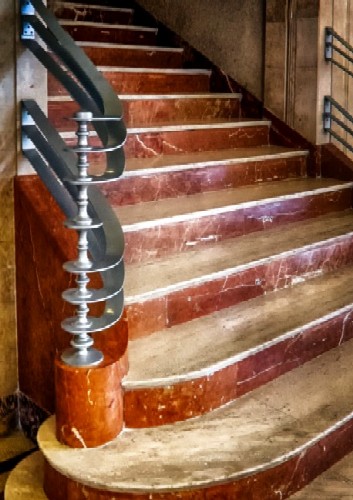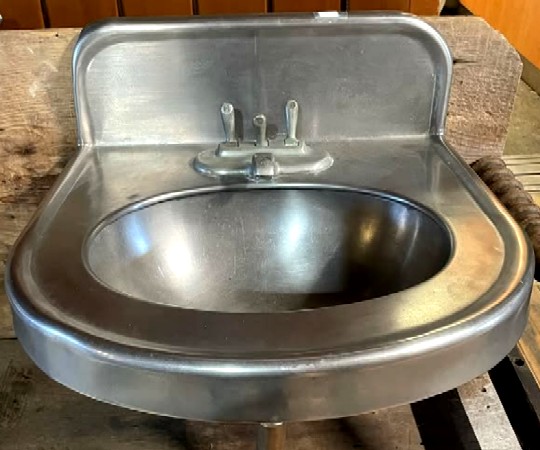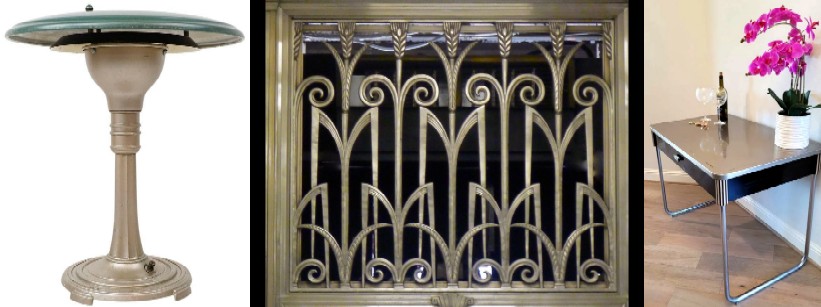
Material - Monel Metal
Let's talk about Monel, a material in use in architecture, furniture and interior design during the late 1920s and early 30s. It is an alloy containing approximately 2/3 nickel and 1/3 copper. Monel was developed in 1905

Monel Stair Railing and Newel, Marble Staircase,
Lakefront
Airport, New Orleans, flickr
by three chemists who were trying to find a cost-effective alternative to nickel silver using the nickel and copper ores found in Sudbury, Ontario. The first ingot was was refined by Robert C. Stanley using nickel and copper. He named it Monel after International Nickel Corporation (INCO) chairman Ambrose Monell, with the second 'l' removed because trademark law didn't allow the use of people's names in official trademarks. (ArtDeco.org)
Stanley eventually became the First Vice President of INCO, championing the metal after demand fell off upon completion of the first World War. In an advertising brochure from 1919, Monel was proclaimed to be "an alloy which will withstand acids, High temperature and the erosive action of hot gases and superheated steam." (The Bayonne Casting Company, Monel Metal, 1919, p. 5) While the metal was smelted in Ontario, Canada by the INCO, it had to be refined for distribution by companies. INCO engaged three companies to produce Monel is usable forms including the Bayonne Casting Company. They noted that the provided it as rods, castings, forgings, tubes, wire, strip stock and sheets among other forms. They explained that it could cast in "very intricate patterns" and could be "worked with equal facility either hot or cold." (Bayonne Casting, p. 7) They show a variety of castings in their brochure, most of which are industrial in nature. However, they also show them being used for golf club heads, promoting the fact that Monel didn't rust as the main selling point. (Bayonne Casting, p. 32)
The promotional material appears to have worked. "By the 1920s, Monel was used in 23 different industries, with uses ranging from naval battleship parts to specialized ice-cream cabinetry. Advertising touted Monel as a white metal that was corrosion proof, stronger than steel and of silvery appearance, brighter than nickel. This wonder metal alloy saw its decorative use exploded during the heady expansion of the art-deco age, while acid and seawater resistance and low coefficiency of expansion, among other properties, saw utilitarian use for industry methodically rise even through the Great Depression." (Nickel Institute) Early uses of Monel were primarily industrial in nature. For example, 264,000 pounds of sheet for the Pennsylvania Railroad Station roof in 1908.

Monel Screen and Clock, Guardian Building, Detroit, MI,
Completed in 1929,
Photo by
Jeff Bondono
One of the more notable examples of the use of Monel in architecture was in the design of the Union Trust Building, renamed the Union Guardian Building in 1929 when Union Trust fell victim to the stockmarket crash, eventually just being called the Guardian Building. It was a bold Art Deco style skyscraper designed by Wirt C. Rowland of Smith, Hinchman & Gyllis and completed in downtown Detroit, Michigan in 1929. Rowland specified Monel for all the exposed metalwork in the building including a large metal screen with a Tiffany clock inside the lobby. (The clock and part of the screeen can be seen at left.) INCO took out a full page ad highlighting Monel's "platinum-like beauty for modern design". (Michigan Manufacturer and Financial Record, volume 43, 1929, p. 69)
"Rowland's use of materials provided a departure from the traditional surfaces of office towers. ...Multicolored Rookwood tiles sheathe the lobby ceiling, accompanied by exotic marble accenting the walls and floor with platinum-colored Monel Metal elevator doors, gates, and handrails. Dominating the lobby is the great Monel Metal screen that once guarded the entrance to what was the main banking room of the Union Commerce National Bank. ...Monel required a very low amount of maintenance, though its properties did not allow for casting, and it could only be rolled and cut. The physical limitations of Monel's properties did not limit Rowland's concept for the building's metalwork; surprisingly, they worked to accentuate his angular, machine-inspired motifs." (James W. Tottis, The Guardian Building: Cathedral of Finance, 2008, p. 2-3)
By 1931, trains, autos and radios were making use of the metal. "Even mundane household items such as the kitchen sink had fresh life breathed into them through fabrication in Monel." (James E. Churchill, "Decorative Monel: Historical Intent, Weathering and Analysis", Columbia University, 2020, p. 19) The world recognition of a new style (later named Art Deco) at the Exposition internationale des arts décoratifs et industriels modernes brought a philosophical shift from the flowery Art Nouveau style to more geometric and mechanically sympathetic shapes in consumer product design. Modernism declared that form should follow function and Art Deco reflected this philosophy.

Monel, Bathroom Sink and Water Levers, Portland Architectural Salvage, Instagram
Monel's silvery appearance made it appealing to designers of such products.
"Dominated by a machine aesthetic, Art Deco played into the hands of the commercial metal suppliers and expanded sales exponentially for white metals. ...Embracing simplicity through rationalised fabrication techniques and the mechanical strength of new alloys, the Bauhaus [movement] reinterpreted classic objects into entirely new forms. The strength, workability and neutral colour palette of white metals became synonymous with the new-fangled modernity, while high gloss finishes evoked the rarity found in gold and glass for a fraction of the cost." (Churchill, p. 21-2)
Monel's extensive use in the domestic market was rather short-lived, however. As with the output of the designers themselves, the stock market crash of 1929 saw a dramatic reduction in the use of Monel in consumer items. Stainless steel began to gain popularity and by the 1930s was being used for a variety of industrial purposes. By 1935, stainless steel sinks had became popular while sales of Monel sinks began to decline. (See "The History of Stainless Steel" and Churchill, p. 26) Unfortunately, unlike stainless steel, Monel didn't retain its silver appearance when exposed to the elements. Stainless was also cheaper and proved to be better for outdoor use. "Monel can in fact turn black, gray, brown, yellow and green, and is subsequently painted, waxed and lacquered." (Nickel Institute) In fact, Monel is often misidentified as bronze or brass because it turns green when corroding. Even when kept indoors and kept clean so that it maintains its silvery appearance, it is often misidentified as stainless, nickel silver or aluminum.
Original Facebook Group Posting
 Monel Pieces, from left - Monel Saucer Lamp, Sight Light Corporation, c. 1940, 1st Dibs; Monel Metal, Transom Window - Above Door, The Chicago Board of Trade Building, flickr; Monel Top Smartline Table, Black Enamel Sheetmetal Body with Chromed Legs, International Nickel Company, Raymond Patten, 1930s, Etsy
Monel Pieces, from left - Monel Saucer Lamp, Sight Light Corporation, c. 1940, 1st Dibs; Monel Metal, Transom Window - Above Door, The Chicago Board of Trade Building, flickr; Monel Top Smartline Table, Black Enamel Sheetmetal Body with Chromed Legs, International Nickel Company, Raymond Patten, 1930s, Etsy